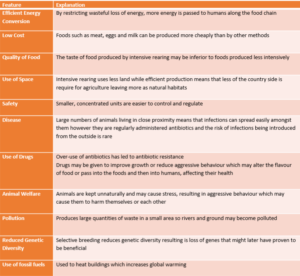Intensive rearing of livestock is designed to produce the maximum yield of meat, eggs and milk at the lowest possible cost.
As energy passes along a food chain only a small percentage passes from one organism in the chain to the next.
This is because much of the energy is lost as heat during respiration.
Intensive rearing of domestic livestock is about converting the smallest possible amount of food energy into the greatest quantity of animal mass.
One way to achieve this is to minimize the energy losses from domestic animals during their lifetime. This means that more of the food energy taken in by the animals will be converted into body mass, ready to be passed on to the next link in the food chain, namely us.
Energy conversion can be made more efficient by ensuring that as much energy from respiration as possible goes into growth rather than other activities or other organisms.
This is achieved by keeping animals in confined spaces, such as small enclosures, barns or cages.
This increases the energy-conversion rate because:
- Movement is restricted so less energy is used in muscle contraction
- The environment can be kept warm in order to reduce heat loss from the body
- Feeding can be controlled so that the animals receive the optimum amount and type of food for maximum growth with no wastage
- Predators are excluded so that there is no loss to other organisms in the food web
Other means of improving the energy-conversion rate include:
- Selective breeding of animals to produce varieties that are more efficient at converting the food they eat into body mass
- Using hormones to increase growth rate

